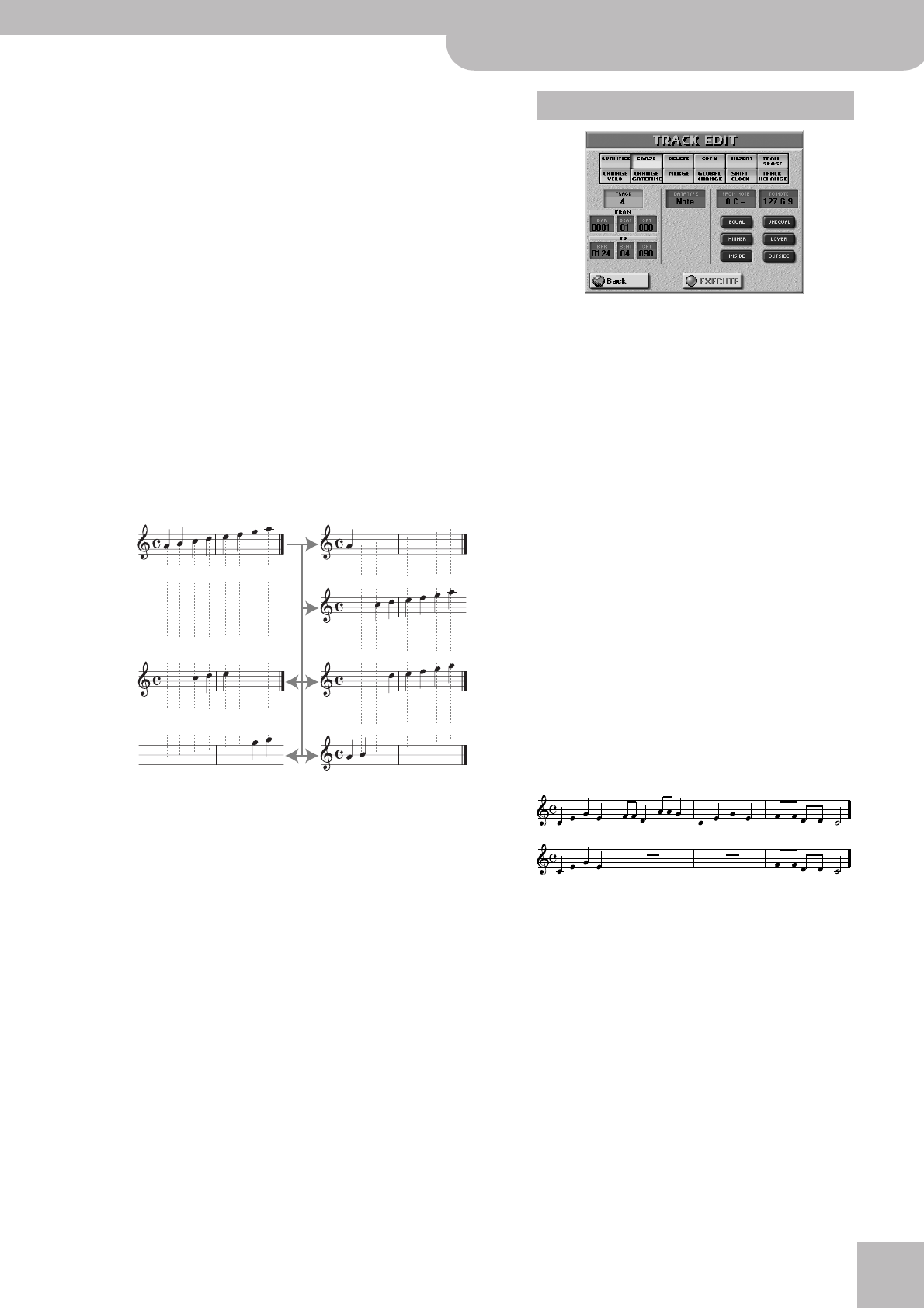
Editing 16-track songs
E-80 Music Workstation
r
181
■Fine-tuning the note range
Before setting “FROM NOTE” (and possibly “TO NOTE”), it
might be a good idea to decide how you want to use the
note indications. Depending on the option you choose,
“FROM NOTE” may not even be available, so that setting it
beforehand would be a waste of time.
■RESOLUTION
(1/4, 1/8, 1/8T, 1/16, 1/16T, 1/32, 1/32T, 1/64)
This parameter sets the resolution of the Quantize func-
tion. Be sure to always select the value of the shortest note
you recorded. Otherwise, your part no longer sounds the
way you played it, because shorter notes are shifted to the
wrong positions.
■STRENGTH (0%~100%)
Use this parameter to specify how precise the timing cor-
rection should be. “0%” means that the selected RESOLU-
TION value is not applied (“0% correction”), while “100%”
means that all notes are shifted to the mathematically cor-
rect positions.
Maybe first try values between “50%” and “85%” to pre-
serve at least part of the original feel. If the result is not
acceptable, repeat the operation with the same or a higher
value.
■EXECUTE
Press this field to confirm your settings and edit the data.
ERASE allows you to selectively delete data either
within a specified range of measures, beats or clocks
or from the entire track(s). When DATA TYPE is set to
“ALL”, ERASE substitutes the required number of rests
for the data you delete, so that you end up with the
equivalent number of blank measures. If you also
want to eliminate the measures themselves, use
DELETE (see below).
■TRACK (ALL, 1~16)
Allows you to select the track you wish to edit. You can
also select “ALL” here, in which case the operation applies
to all tracks except the MASTER track. The MASTER track
can only be selected and edited in isolation (see p. 189).
■FROM
● BAR (1~[last measure of the track or song])—Refers to
the first measure to be edited. By default, the FROM
value is set to the beginning of the selected track(s).
● BEAT (1~[number of beats per bar])—Specifies the
beat position. The number of available beats depends on
the time signature in the selected area.
● CPT (1~119)—Refers to the starting CPT position. “CPT”
is short for “Clock Pulse Time”, the smallest unit used by
the E-80. (There are 120 CPTs to every beat of a 4/4 bar.)
Change this setting only if your edit operation should
start after the selected beat.
■TO
By default, the TO position is set to the last event of the
selected track (or the last event of the longest track when
you select “ALL”).
● BAR (1~[last measure of the track or song])—This is
where you specify the bar position of the last measure to
be edited.
● BEAT (1~[number of beats per bar])—Specifies the
beat position. The number of available beats depends on
the time signature in the selected area.
● CPT (1~119)—Refers to the last clock that should be
affected by the edit operation. Change this setting only
if your edit operation should not end exactly on the
selected beat.
[EQUAL] Only the selected note (note name/note num-
ber) will change. (The note can be set using
the TO NOTE field.)
[UNEQUAL] All notes except the one you select will
change. (The note can be set using the TO
NOTE field.)
[HIGHER] Only notes above the selected one will
change. (The note can be set using the THAN
NOTE field.)
[LOWER] Only notes below the selected one will
change. (The note can be set using the THAN
NOTE field.)
[INSIDE] Only the notes between FROM NOTE and TO
NOTE will change.
[OUTSIDE] Only the notes below FROM NOTE and above
TO NOTE will change.
q
”
TO NOTE: 69 (A4) [EQUAL]
TO NOTE: 69 (A4) [UNEQUAL]
THAN NOTE: 72 (C5) [HIGHER]
THAN NOTE: 72 (C5) [LOWER]
TO NOTE: 76 (E5)
FROM NOTE: 72 (C5) [INSIDE]
&
c
q
q
q
_
”
TO NOTE: 76 (E5)
FROM NOTE: 72 (C5) [OUTSIDE]
Original phrase
ERASE
Erase NOTE From 2.1.0 To 4.1.0
